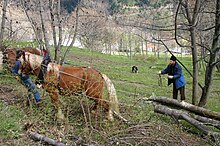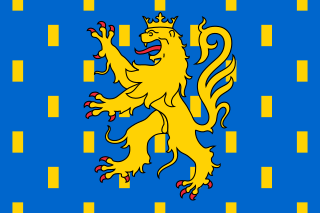
Franche-Comté is a cultural and historical region of eastern France. It is composed of the modern departments of Doubs, Jura, Haute-Saône and the Territoire de Belfort. In 2016, its population was 1,180,397.

The Percheron is a breed of draft horse that originated in the Huisne river valley in western France, part of the former Perche province, from which the breed takes its name. Usually gray or black in color, Percherons are well-muscled, and known for their intelligence and willingness to work. Although their exact origins are unknown, the ancestors of the breed were present in the valley by the 17th century. They are believed to descend from war horses. Over time, they began to be used for pulling stagecoaches; and later, for agriculture and hauling heavy goods. In the late 18th and early 19th centuries, Arabian blood was added to the breed. Exports of Percherons from France rose exponentially in the late 19th century, and the first purely Percheron stud book was created in France in 1893.

The Cleveland Bay is a breed of horse that originated in England during the 17th century, named after its colouring and the Cleveland district of Yorkshire. It is a well-muscled horse, with legs that are strong but short in relation to the body. The horses are always bay in colour, although a few light hairs in the mane and tail are characteristic of some breed lines. It is the oldest established horse breed in England. The ancestors of the breed were developed during the Middle Ages for use as pack horses, when they gained their nickname of "Chapman Horses". These pack horses were cross-bred with Andalusian and Barb blood, and later with Arabians and Thoroughbreds, to create the Cleveland Bay of today. Over the years, the breed became lighter in frame as they were employed more as carriage and riding horses. The popularity of the Cleveland Bay has greatly fluctuated since it was first imported to the United States in the early nineteenth century. Despite serious declines in the population after the Second World War, the breed has experienced a resurgence in popularity since the 1970s, although only around 550 horses existed worldwide as of 2006.

The Russian Don is a breed of horse developed in and named after the steppes region of Russia where the Don River flows. Utilized originally as cavalry horses for the Cossacks, they are currently used for under-saddle work and driving.
The Galiceno is a horse breed developed in Mexico, bred from horses brought from Spain by Hernán Cortés and other conquistadors. Although small in stature, they are generally considered a horse, rather than a pony, and are always solid-colored. In Mexico, they are an all-around horse, used for riding, packing and light draft. In the United States they are often used as mounts for younger competitors, although they are also found competing in Western events. The breed descends from horses brought from Spain to Mexico during the 16th century. Many of these horses escaped or were released and formed feral bands in the interior of Mexico, which were then captured by local inhabitants. They were also often used by Spanish missionaries to the American West, where they became some of the ancestors of the American Indian Horse. In 1958, these horses were first imported to the United States, and in 1959 a breed registry was formed. Many of the horses are also registered with the American Indian Horse Registry.
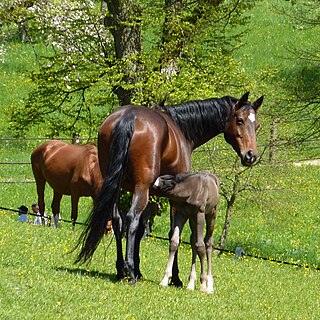
The Württemberger, Baden-Württemberger or Württemberg is a Warmblood horse breed originating in Germany. They are primarily riding horses, and are selectively bred for dressage and show jumping.

The Ardennais or Ardennes is one of the oldest breeds of draft horse, and originates from the Ardennes area in Belgium, Luxembourg, and France. They are heavy-boned with thick legs and are used for draft work.

The Budyonny is a breed of horse from Russia. It was bred as a military horse after the Russian Revolution of 1917; in the twenty-first century it is used as an all-purpose competition horse and for driving.

The Boulonnais, also known as the "White Marble Horse", is a draft horse breed. It is known for its large but elegant appearance and is usually gray, although chestnut and black are also allowed by the French breed registry. Originally there were several sub-types, but they were crossbred until only one is seen today. The breed's origins trace to a period before the Crusades and, during the 17th century, Spanish Barb, Arabian, and Andalusian blood were added to create the modern type.

The Freiberger or Franches-Montagnes is a Swiss breed of horse of light draught type. It originates in the Canton of Jura in north-western Switzerland, and is named for the Freiberge or Franches-Montagnes District in the south of that canton. It is widely distributed in Switzerland, and is also present in France and Belgium.
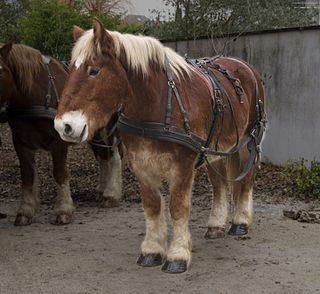
The Trait Breton is a French breed of draught horse. It originated in Brittany, in north-west France, from cross-breeding of local horses with various other breeds. It is strong and muscular, and often has a chestnut coat.
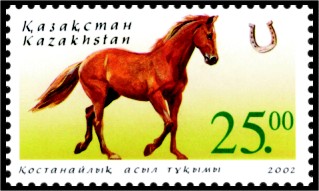
The Kustanair is a breed of horse developed in Kazakhstan in the former U.S.S.R. in the late 19th and early 20th centuries. They are used mainly for under-saddle and light draft work.
The Lokai, a mountain horse bred in Tajikistan, is used as a riding horse, a packhorse, or even sometimes a light draft horse. Although small, the breed is agile and hardy. The breed was developed by crossing native mountain horses with a mixture of Central Asian and European bloodlines.
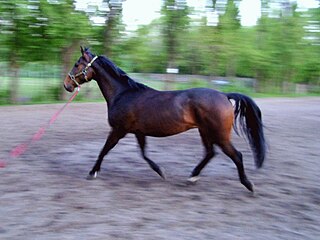
The Malopolski is a Polish horse breed developed in the 19th century in Lesser Poland, Polish Małopolska, hence the name. It is versatile breed, used today for light draft and under-saddle work. It was developed mainly from native Polish horses crossed with Thoroughbreds and Arabians, and a 2006 study shows a strong genetic presence of Thoroughbred bloodlines within the breed today. Population numbers have been in decline since the late 20th century, but genetic studies show little danger of inbreeding at this time.

The Auxois is a horse breed from eastern France. It is a large breed, with some individuals weighing over 910 kilograms (2,010 lb), bred for horse meat, agricultural work and leisure pursuits. Overall, members of the breed are solid and muscular in appearance. They are usually bay or bay roan in color, although some other colors are accepted by the breed registry, and are known for their power and docility.

The Jutland horse is a draft horse breed originating in Denmark, named after the Jutland Peninsula which forms the western part of the country. Usually chestnut, they are a compact, muscular breed known for their calm and willing temperament. The breed was originally developed for use in agriculture, but today is more often seen in urban settings and at horse shows. Some of the best known members of the breed pull beer wagons for the Carlsberg brewery around Copenhagen, as well as at competitions and for demonstrations. Images from the 9th century show a horse similar to the Jutland being used by Viking raiders in what is now Great Britain. The first written record is from the 12th century, when they were popular as war horses. Some infusion of bloodlines from other breeds occurred in the 18th century, but the modern Jutland type only began about 1850 with the addition of blood from several other breeds, mainly draft horses. A stud book was created in the late 19th century, and the Jutland population grew to a maximum around 15,000 by 1950. Numbers subsequently declined, and as of 2011, only an estimated 1,000 horses remained.
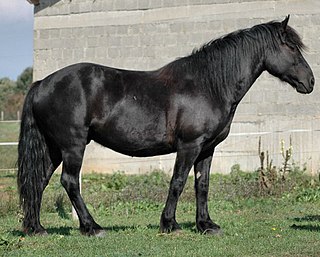
The Mérens, Cheval de Mérens or Caballo de Merens, still occasionally referred to by the older name of Ariégeois pony, is a small, rustic horse native to the Pyrenees and Ariégeois mountains of southern France, where the river Ariège flows, and northern Spain, near Andorra. Two general types, a small, light traditional mountain horse and a taller, sportier modern type, are found. Always black in color, Mérens must meet strict physical standards in order to be registered in the stud book. The breed is known for its sure-footedness on mountain terrain, as well as for its endurance, hardiness and docility. The French breed registry organizes regional offices, and partners with other national organizations in Europe to preserve and promote the breed. The organization enforces rigorous selection of breeding stock, with a goal of increasing quality in the breed. In the past, the Mérens was used for farm work, draft work and as pack horses. Today it is mainly used as a saddle horse, although some members of the breed have been successful in carriage driving. Many Mérens are taken on an annual transhumance, in which they are moved higher in the mountains during the summer and into the valleys for the winter. An old practice, it fell into disfavor, but has recently re-emerged.
The Calabrese is a breed of horse originating from Italy, generally used for riding. They were developed from horses bred in Italy before the founding of Rome, and the breed has continued to be developed to the present day through infusions of Arabian, Andalusian and Thoroughbred blood.

The Kazakh Horse is a horse breed of the Kazakh people, who live mainly in Kazakhstan, but also in parts of China, Mongolia, Russia and Uzbekistan. It is used mainly as a riding horse, and is known for its hardiness and stamina.
The Karacabey horse is a now-extinct horse breed. It was a light riding horse that originated in Turkey.

